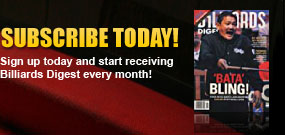|
On the Rail August 2012
IT HAS got to be one of the most basic fears for beginner and intermediate pool players — you’ve made the shot at hand and the cue ball looks like it’s rolling in perfect position for your next shot. Only it comes up a few inches too short or too long and the cue ball cozies up to the cushion.
Dealing with a cue ball that’s frozen to, or very nearly frozen to, the rail can be daunting because it can put you in a difficult spot. You’re limited by the fraction of the cue ball you can see, instead of having the entire ball to work with. But with a little work and an slight adjustment in your mental approach, you can begin to overcome your fear of the rails.
First of all, if the cue ball is an inch or two off the rail, you can hit closer to center-ball if you raise the back of your cue and hit at a downward angle. If this is a possibility, you will have to tweak your stance to accommodate the cue’s elevation. Instead of keeping the forearm of your bridge arm straight, bend it a bit and move your torso forward toward the cue ball. You want your back arm to have space to properly stroke the shot. If you can keep your back elbow at a 90-degree angle and your upper body is perpendicular to the cue, you should be in good shape.
Now, as far as your cue’s contact point on the cue ball, you have to be realistic. If you are a few inches from the rail, like we discussed previously, you have a little more room to work with. You can at least hit the ball along the horizontal axis, if not lower.
But if you are completely frozen to the rail, the options are limited. Depending on what you need to do with the cue ball after it hits the object ball, you may want to use left or right English. I strongly advise against this. Because you’re already hitting so high on the cue ball, venturing away from the vertical axis is going to greatly decrease your control.
During the delivery of your stroke, be sure to maintain the cue’s even plane. You will be hitting down slightly, so be sure to deliver a smooth stroke straight through your contact point. If you lift up the cue, you may hit the cushion and bounce up and top the cue ball. If you lower your back arm, you may hit the cue ball too high and miscue.
|





